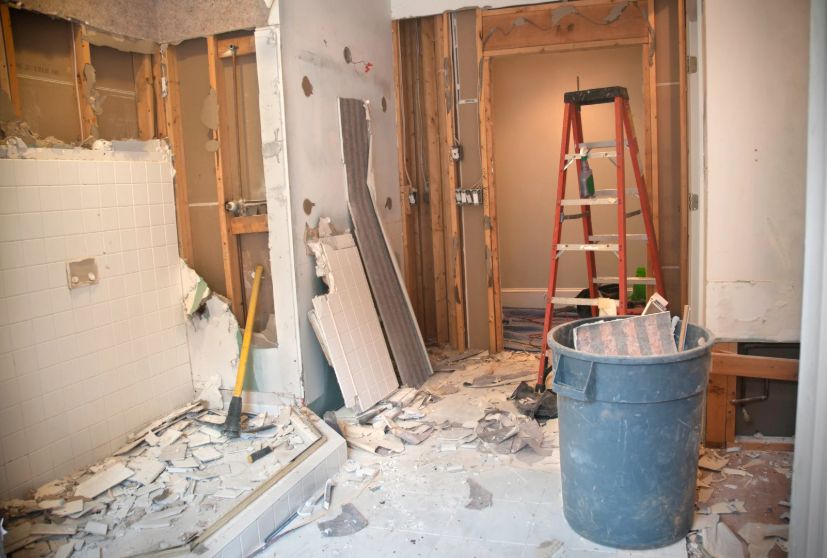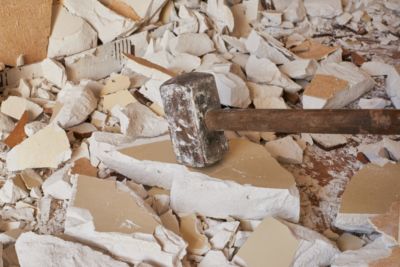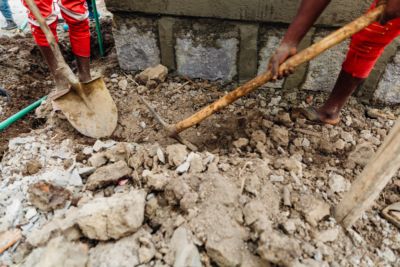
Tips for Concrete Removal in Busy Neighborhoods
September 10, 2025
Best Practices for Flooring Removal and Disposal
September 10, 2025What’s Involved in Kitchen Demolition?
When it comes to home renovations, few projects are as exciting and intimidating as kitchen demolition. The heart of the home is about to undergo major changes, and before new cabinets, countertops, or appliances can be installed, the old must be carefully removed. While the thought of smashing through outdated cupboards may sound appealing, the process requires far more planning and precision than most homeowners expect. Proper preparation, the right tools, and clear safety measures all play a role. Understanding what’s truly involved in kitchen demolition helps ensure that the project runs smoothly and avoids costly mistakes.
Preparing the kitchen space for demolition
The first step in kitchen demolition is preparing the area. Clearing out appliances, dishes, and personal items ensures the workspace is ready and safe. Protective coverings should be placed over nearby floors and entryways to limit dust migration to other parts of the home. Proper preparation also involves shutting off utilities like water, gas, and electricity before any structural work begins. These safety measures prevent dangerous accidents and reduce unexpected complications.
In addition, homeowners should establish a designated disposal area outside the kitchen. Buckets, bins, or tarps can be used to collect debris as it accumulates. This level of organization may seem unnecessary, but it saves time during cleanup and keeps the demolition process efficient. Preparing thoroughly not only safeguards the home but also makes the subsequent steps less overwhelming. A well-prepared space sets the foundation for a successful demolition project.
Disconnecting appliances and utilities safely
A critical part of kitchen demolition involves disconnecting utilities and appliances. Gas lines must be shut off properly to avoid leaks, while electrical connections to ovens, microwaves, and refrigerators should be safely disconnected. Even water lines to sinks and dishwashers require careful handling to prevent leaks or flooding. Taking shortcuts during this stage can lead to dangerous consequences, which is why many homeowners call in professionals for assistance.
Removing appliances like stoves, refrigerators, and dishwashers is more than just unplugging or unhooking them. Many are heavy and awkward to move, requiring proper lifting techniques or additional manpower. Some may also contain components that need to be disposed of properly, such as refrigerants in old fridges. Ensuring that these appliances are removed safely not only protects the home but also makes the demolition process more efficient. Safety and careful planning are the cornerstones of this step.

Removing cabinets and countertops
Cabinet and countertop removal is often one of the most satisfying aspects of demolition, but it still requires precision. Upper cabinets should be removed first to prevent them from collapsing unexpectedly while working on lower sections. Screws, nails, or adhesive securing them to the wall must be carefully released. Once detached, cabinets should be lowered carefully to avoid damaging walls or flooring.
Countertops can present unique challenges depending on the material. Laminate tops may come loose easily, while stone or concrete counters require heavy lifting and sometimes specialized equipment. Careful handling during removal minimizes the risk of damaging underlying cabinetry or walls that may remain in place. Proper disposal of these bulky materials also needs to be factored into the process. Whether salvaging reusable pieces or arranging junk hauling, cabinet and countertop removal is a step that demands patience and strength.
Taking down walls when necessary
Not all kitchen demolitions require wall removal, but in many remodels, opening up space is the goal. Taking down walls requires a clear understanding of which are load-bearing and which are not. Mistakes here can have major consequences for the home’s structure. Consulting with a professional or structural engineer before swinging a hammer ensures safety and protects the integrity of the building.
Once it’s confirmed that a wall can be removed, proper tools like reciprocating saws and sledgehammers help break it down efficiently. Dust barriers and debris control methods should be in place before starting. Wall removal often reveals hidden wiring or plumbing that must be handled with care. This makes the process slower and more detailed than many expect. However, when done correctly, removing walls transforms a kitchen, creating open layouts and brighter spaces.
Flooring removal during kitchen demolition
Flooring is another major component of kitchen demolition, and the type of material dictates how complex the task will be. Tile removal requires chisels, hammers, and sometimes power tools to break through adhesive layers. Vinyl and laminate often peel up more easily, though they can still leave behind stubborn glue. Hardwood flooring can be nailed, glued, or stapled down, making its removal a time-consuming process.
Removing flooring also exposes the subfloor, which should be inspected for water damage, rot, or uneven areas. Repairing these issues during demolition prevents costly problems later when installing new flooring. Debris from flooring removal can accumulate quickly, so frequent cleanups keep the work area manageable. Flooring demolition may feel like a separate project on its own, but it’s a vital part of creating a blank canvas for the new kitchen design.
Managing dust and debris during demolition
One of the biggest challenges during kitchen demolition is managing dust and debris. Demolition generates massive amounts of particles that can spread throughout the home if not properly contained. Using plastic sheeting, sealing off vents, and employing shop vacuums with HEPA filters helps maintain a cleaner environment. Proper ventilation is equally important, especially when adhesives or paints are disturbed.
Debris should be gathered systematically as the demolition progresses. Dumping everything in one pile often slows down the process and creates hazards. Using buckets, bags, or small bins makes removal more manageable. Larger items, like countertops or old cabinets, should be removed from the site as soon as possible to free up space. By staying on top of dust and debris, homeowners make the entire project less stressful and more efficient.
Recycling and disposal of materials
Kitchen demolition produces a wide range of materials, from wood and drywall to tile and metal fixtures. Not all of it should go to the landfill. Many materials can be recycled, repurposed, or donated. For example, wood cabinetry might be salvaged for reuse, and metals like stainless steel or aluminum can often be recycled locally. Even old appliances may be accepted by recycling facilities if properly processed.
Proper disposal planning makes a huge difference in the efficiency of the project. Having designated bins or piles for different materials helps ensure they are sorted correctly from the start. Professional junk removal services often provide eco-friendly disposal options, handling the hauling and recycling for homeowners. By focusing on sustainable practices, demolition projects reduce their environmental impact while keeping work areas cleaner and more organized.
Safety considerations for homeowners and crews
Demolition work comes with inherent risks, so safety precautions should never be overlooked. Sharp objects, heavy materials, and hidden hazards like mold or asbestos may be encountered during a project. Wearing protective gear such as gloves, masks, and safety goggles is essential. Proper footwear with non-slip soles also helps prevent accidents when dealing with debris.
For larger or more complicated demolitions, it’s wise to bring in professionals who know how to handle potential hazards safely. Structural issues, gas lines, and electrical systems can all create dangerous situations if handled incorrectly. Establishing clear communication among everyone involved in the project further reduces risks. Safety isn’t just about protecting people; it also safeguards the home and ensures the project continues without unnecessary setbacks.
Hiring professionals for kitchen demolition
While some homeowners may feel confident tackling smaller demolition projects themselves, larger or more complex kitchens often require professional expertise. Experienced demolition teams bring knowledge, efficiency, and the proper equipment to handle every step safely. From disconnecting utilities to hauling away debris, professionals streamline the process and reduce stress for homeowners.
Hiring experts also ensures that the demolition complies with local regulations and disposal requirements. Professionals are better equipped to manage unexpected complications, like hidden water damage or structural issues, that can delay projects. Investing in a professional demolition team ultimately saves time and reduces costly mistakes. For many homeowners, the peace of mind gained is worth the additional expense.
Planning for the renovation ahead
Demolition is only the first half of a kitchen transformation. Planning for what comes next is just as important as tearing down the old. A clean, prepared space gives contractors a fresh start for installing new cabinets, flooring, and appliances. Addressing subfloor or wall repairs during demolition ensures a smoother renovation phase.
Having a renovation plan in place also helps determine how much demolition is needed. For example, if some cabinetry will be reused, it must be removed carefully rather than destroyed. Aligning demolition efforts with renovation goals keeps the project on track and minimizes wasted time and money. A thoughtful approach to planning bridges the gap between demolition and construction, making the overall project more successful.
Conclusion
Kitchen demolition is far more than swinging hammers and tearing down cabinets. It’s a process that requires planning, precision, and a strong focus on safety. From disconnecting utilities and removing cabinets to handling debris and preparing for renovation, each step plays a vital role in the transformation. Managing dust, recycling responsibly, and repairing hidden structural issues are just as important as the physical act of demolition. With careful preparation and smart disposal strategies, the project becomes less overwhelming and sets the stage for a smooth renovation.
For homeowners in Santa Rosa, CA, North Bay Junk Removal provides reliable junk removal services to handle the aftermath of demolition. Their team is equipped to haul away cabinets, countertops, flooring, and other debris efficiently and responsibly. Whether preparing for a small update or a full-scale remodel, their services simplify cleanup and disposal. Call 707-478-6817 today to schedule professional junk removal and keep your renovation project moving forward without the hassle.



